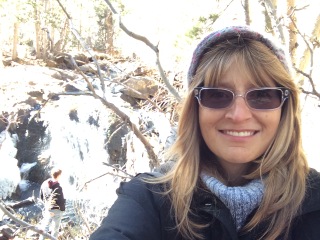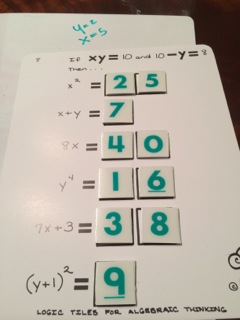1001 Circles: an environmental geologist wants to save the world, runs a Math Club
 Debbie Vane is an environmental geologist turned mentor in mathematics and science. She has developed a math club for homeschool students ages 6-14, including her son, to help them learn problem-solving strategies. In the club, everyone works on the same concept, but solves different problems. Debbie supports mixed-age groups, because they are more representative of the real world.
Debbie Vane is an environmental geologist turned mentor in mathematics and science. She has developed a math club for homeschool students ages 6-14, including her son, to help them learn problem-solving strategies. In the club, everyone works on the same concept, but solves different problems. Debbie supports mixed-age groups, because they are more representative of the real world.
Here is Debbie Vane’s interview for 1001 Circles, a series of stories that show what a math circle might be like, from the point of view of circle leaders. We hope these stories will inform and inspire you to lead a circle of your own. If you lead a math circle, an engineering club, or an informal playgroup, we would like to hear your story or interview you. Write moby@moebiusnoodles.com to talk about your adventures.
Please tell us about yourself. What are your dreams regarding students and mathematics?
From an early age, I wanted to save the world, really. After spending years as an environmental geologist cleaning up soil and groundwater, I became discouraged by the lack of commitment of big business to clean up their act. I decided the best way to facilitate change was to educate future generations. As a teacher, I instill a love of learning and stewardship of the planet by showing that everything is connected. My background as a scientist naturally led me to teach math — the language of science. Today, as a homeschooler of my son and other children, my goal is to inspire a love of learning of math, break down negative patterns from past experiences with math, and empower students to be the creators of their knowledge. I am less of a teacher and more of a mentor, assisting each student to find their innate talents and set their own learning goals.
What helped you to start the club when you decided it’s needed? What kept you going?
I had taught middle school math for a few years. The greatest impact on learning was always cooperative projects. I decided to start a Math Club for homeschoolers, using projects and simulations as the spine of the club. The enthusiasm and excitement of the kids in the club confirmed that the club was needed and enjoyed by all.
How does it feel to have a wide range of ages together? How do you adapt activities?
Prior to homeschooling, I had never experienced or taught in a multi-age class setting. Having a class with kids ranging in age from 6 to 14, I quickly saw the benefits! For example, I offered a problem-solving unit using an Interact program called MathQuest. Kids traversed MathLand in teams. They earned travel dots by solving and writing word problems. Along the way, the kids drew fate cards, which were always entertaining, and purchased supplies to help them navigate the path.
In one group, there was a 9 year old and a 13 year old. The two students approached problem solving differently. One student was visual and the other student needed to express their thought processes out loud. The 13 year old would draw a picture of the problem, and the 9 year old would verbalize her understanding of the drawing. They worked together until they had a shared understanding and solved the problem.
A benefit of multi-age classes is that the students rarely compare themselves to others. They recognize everyone is of a different age, so there is no sense of competition to be better than one another. There is a general acceptance that everyone is unique, with different levels of skills. There is more cooperation in the class. A 13 year old recalls their skills and challenges when they were 9 year old. They are patient, helpful, and feel like they are a mentor to the younger student. Sometimes, the younger child may have a better understanding and the roles are reversed. I model that all of us have strengths and weaknesses in math and that comparing ourselves to others isn’t useful for developing our understanding. My ultimate goal is for kids to feel comfortable with their skill level wherever they are, and to believe that their worth isn’t tied to what they know but to who they are. This is the reverse of the current competitive world.
When we were learning the problem-solving strategies, each child received different word problems to solve that were appropriate for their age and skill level. Parents always asked me if it was way too much work to create problems for each individual student. My response was always that education needs to be tailored to individual needs. While it was “extra” work for me, it was worth it because I saw growth in each individual, not only in skill level but also in confidence.

Can you share an activity from your club?
I like Marcy Cook’s tile activities. They require critical thinking, are challenging, and don’t ask kids to write to solve problems. The students like the activities. Who doesn’t like to solve a puzzle? The tile packet activities range from operations with numbers to geometry concepts and algebraic reasoning. Students work on a tile activity by themselves, and then ask another student to check their work and offer different solutions. Here is my photo of a tile activity card.

What would you recommend to someone who is thinking of leading a math club or math circle for the first time?
I would recommend to start small and stay within your wheel house. Choose content that you have mastered so that you have confidence to mentor the students in all areas of the topic.
I also believe that it is so important to let the students direct the learning. Go with their interests. Find a way to bring the content into their arena, and you will have willing and eager students.
Finally, embrace and celebrate mistakes. The author Neil Gaiman said, “Make interesting mistakes, make amazing mistakes, make glorious mistakes.” If a student makes a mistake a lot of times, they equate that to not being smart or capable. We need to help students see mistakes as opportunities to learn. I intentionally make mistakes and let them correct me! I laugh when I make a mistake, and model that it doesn’t affect my confidence, my self esteem, or my desire to persevere and solve problems.
Related Posts
Posted in A Math Circle Journey, Grow







Leave a Reply